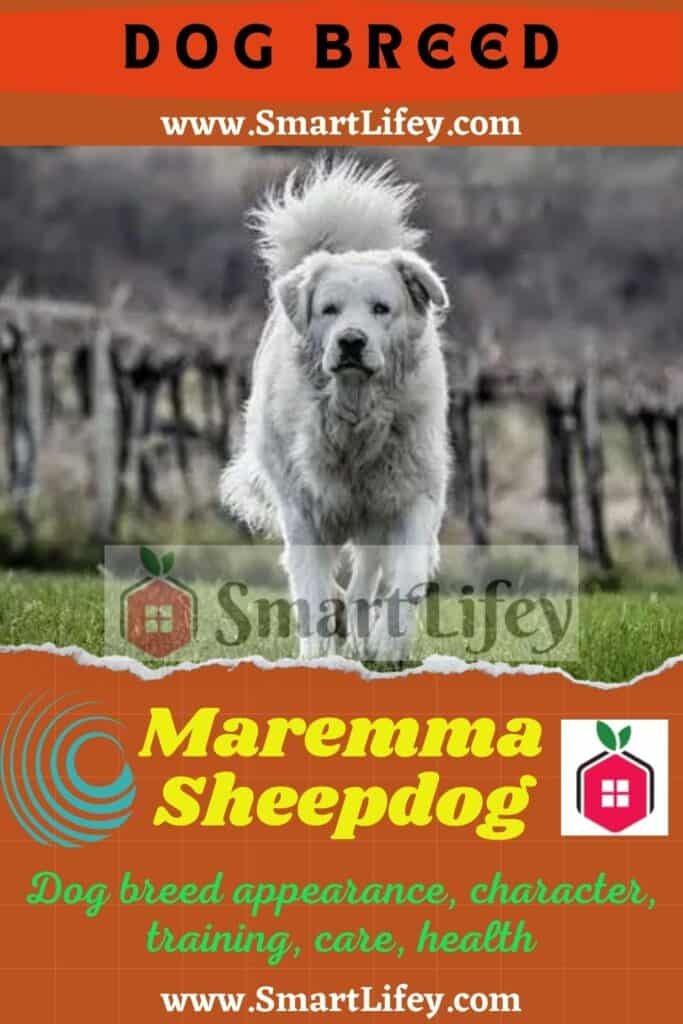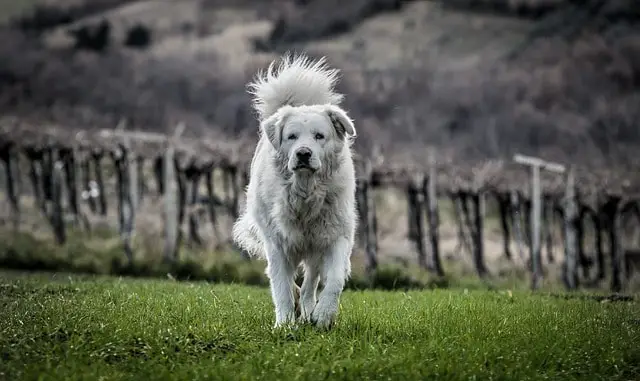
The Maremma Sheepdog breed is characterized mainly by its beautiful white coat and its large size. From its behaviour it stands out that it is very brave, determined and intelligent. It is a dog who loves family and children. At Petlifey, we explain the characteristics and character of the Maremma shepherd.
Character of the breed Maremma Shepherd
The behaviour of the Maremma Shepherd is that of a very intelligent, courageous and determined dog. Despite having a haughty temperament and little inclined to submission, it knows how to manifest devotion to its master and those around them.
It is vigilant, with great capacity for concentration and is psychologically very balanced. It learns easily, but can be a bit rebellious and stubborn.
- Energy: high level. You need to get regular exercise outside, but it doesn’t have to be too strenuous.
- Adaptability: low. It needs open spaces for its good balance, with which it cannot live in an urban environment.
- Sociability: medium. It is very suspicious of strangers, developing aggressive attitudes.
- Health: Good. Life outdoors helped keep them in good health. There are no signs of hereditary diseases.
- Longevity: low / medium. Live 8-11 years if well cared for.
- Utility: versatile. It can work as a herding, guard and defence, and companion dog.
- Use: grazing and storage.
Can you live in an apartment?
It cannot be recommended as a good city dog, much less if you are going to have to live in an apartment, since due to its shepherd nature it needs large open spaces.
It needs to run outdoors to perform physically and mentally, and living in a flat can stress them out and make them a nervous, destructive and biting animal.
However, if you live in the country and have the possibility of running extensively, you no longer need any other specific exercise, since you are calm in nature and it is not in your genetics to carry out your work so intensively.
Is it a family dog?
The Maremma Shepherd tolerates the presence of other dogs and all kinds of animals well, and enjoys very much the company of children and other members of the family.
On the contrary, it is very reserved with strangers, and does not allow them to enter its territory if they are not accompanied by a member of the human family with which it lives.
Characteristics of the Maremma Shepherd
The Maremma sheepdog breed is characterized by being large. Its body is longer than tall, powerful, rustic in appearance and at the same time majestic. It is a strong dog with a very elegant appearance, mainly due to its white coat.
How is the Maremma Shepherd breed physically?
Its head is large and flat, has a conical shape and is similar to that of the white bear. The skull is broad, with a powerful muzzle; the stop, slightly accentuated, and the nose, large and black.
The eyes are rather small, they are ocher or dark brown in color. Located in a lateral position, they are almond shaped with the edge of the eyelids black. Its gaze is attentive and alert.
The ears are small in size, very mobile and drooping. They are triangular in shape, with a narrow insert and a sharp point, not blunt. Some dogs are amputated.
It has a foot great, the front are round, whereas the later are somewhat oval. The fingers are close together and covered in short, dense hair, with dark nails.
The tail is set low due to a very drooping croup, at rest it falls beyond the hock, with the curved end In movement it raises it up to the line of the back
Fur
Double-layered, the outer coat is dense, long (about 8 cm on the back), rather rough to the touch and quite close to the body, always in solid white. The hair is very thick, long and rather rough to the touch, resembling a stiff mane.
It is well attached to the whole body and in some specimens it is slightly wavy. It forms an important collar around the neck and not very long fringes on the posterior edges of the extremities.
Rather, it is short on the muzzle, skull, ears, and front edge of the limbs. In winter, the undercoat becomes very thick.
Colour
This dog always has a solid white coat, although there are some specimens that have slightly ivory tones, pale orange or very soft yellow.
Maremma Shepherd breed standard
- General appearance: large, powerful, rustic in appearance and stately bearing.
- Size: very large.
- Height at the withers: 65-73 cm (Males) and 60-68 cm (Females).
- Weight: 35-45 kg (Males) and 30-40 kg (Females).
- Other names: Maremma and Abruzzes Sheepdog / Berger de la Maremme et des Abruzzes / Maremme-Abruzzen-Scháferhund / Cañe da pastore Maremmano-Abruzzese.
- Head: overall it is large and flat, conical in shape and quite similar to that of a white bear.
- Skull: good breadth and convex seen in profile. The superciliary arches are moderate and the mid-frontal sulcus, little marked. Naso-frontal depression (stop): It is not very accentuated.
- Muzzle: shorter than the skull, decreases in thickness towards the nose. Nose: It is quite large and black in color.
- Jaws: robust in appearance, with white and well developed teeth. The bite is scissor.
- Eyes: not too big. The eyeball is presented in a lateral position and is neither sunken nor protruding. The gaze is alert and attentive and the dominant color is ocher or dark brown.
- Ears: placed well above the superciliary arches and insertion not very wide, they are drooping, but very mobile. They have a triangular shape and end in a point. In dogs that are used to drive herds, the ears are allowed to be cut off.
- Neck: short, thick, very robust, muscular and without dewlap. It is covered with a showy collar of long and bushy hair, more visible in males.
- Body: solid construction and rectangular profile, the upper line is straight from the withers to the rump and oblique from it.
- Back: rectilinear in profile and somewhat arched, with well developed and broad muscles. The withers slightly protrude from the line of the back. The rump, slightly sloping, is broad, robust and very muscular
- Chest: broad, deep and very convex at half its height, descending to the elbows. The ribs are tight and oblique, with wide intercostal spaces. The last false ribs are long, oblique and very open.
- Tail: set low, when the dog is at rest it goes beyond the hock. In movement, it takes it to the level of the back, with the tip quite curved. It is covered with thick hair and no fringes.
- Forelimbs: both in front and in profile, the poles are uniform and harmonious, and are in proportion to the rest of the body.
- Shoulders: long and oblique, with powerful muscles, with very free movements.
- Forearms and arms: the first are straight and vertical, with robust bones; the arms are close to the body in the upper two-thirds of the way and the muscles are strong.
- Hindlimbs: the aplomos are uniform, harmonious and provided with the rest of the body.
- Legs: they have strong bones, lean muscles and have well-defined leg grooves.
- Knees: they are perfect in the vertical of the limb, without deviating either inwards or outwards- The angulation is quite open.
- Feet: they are large, round (the rear more oval), with the toes together and covered with short and dense hair. The nails are black or dark brown.
- Movement: the step and the trot are elongated.
- FCI Classification: FCI No. 201. GROUP 1 – Sheepdogs and Cattle Dogs (except Swiss Cattle Dogs). Section 1 – Sheepdogs.
Maremma Shepherd Training and Education
The training of the Maremma shepherd breed should begin at an early age.
As they have always been educated to know how to remain alone with the herd and to be able to make decisions for themselves, sometimes they can be stubborn and even reluctant to comply with an order if they consider that it is not the most appropriate to solve a certain situation.
For this reason, the Maremmano-Abruzzese pastor must be educated with authority and firmness, but always with calm and understanding.
Its master must learn to wisely play the role of leader of the pack with its dog, an authoritative position that the dog will always respect.
For all these reasons, this is not exactly the best dog for a new owner. On the other hand, its natural aggressiveness should never be stimulated, as it can end up becoming a violent and biting animal.
Health and diseases of the Maremma Shepherd
Being a rustic dog selected for work, it does not present serious health problems, except those that may be related to its large size. Thus, it is important to always keep it at its proper weight if joint problems are to be avoided.
On the other hand, you should also take extreme care of the ears, since due to their specific nature it can produce more earwax than normal and end up generating an annoying otitis.
Accustomed to living outdoors, the specimens of this breed adapt to living in practically any climate, although the truth is that very hot places can negatively affect them.
They generally prefer to sleep outside, although they can get used to sleeping indoors if their master wants it to. But, ultimately, the open space is for these shepherd dogs a guarantee of their good health.
Feeding of the Maremma Shepherd
You have to carefully watch the feeding of this animal, as it tends to suffer from gastrointestinal ailments that can become complicated over time.
Their caloric needs are high and, in this sense, it is desirable to provide them with a food with a high energy density, since, in addition, in this way the size of the servings can be reduced, or the daily intake can be divided into two doses.
Hygiene and care of the Maremma Shepherd

The Maremma Shepherd does not need a specific cosmetic arrangement. Regarding the bathroom, it is recommended to reserve it only for when the animal is really dirty, a moment that can be used to cut its nails and fix its feet.
On the other hand, it is essential to practice a thorough and regular brushing of the coat, as it is very dense and abundant. Also, as its shedding is also very extensive, it should be brushed even more regularly during this stage to remove all dead hair.
The most suitable way to work the undercoat is with a rake because this will undo any possible knots, while the covering mantle can be combed with a good metallic card.
Such simple tasks will be enough for the owner of a Maremma shepherd to be fully proud of the silhouette of its pet, which is at the same time rustic, majestic, strong and elegant.
